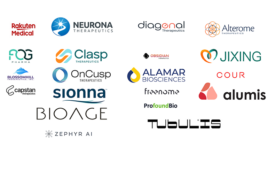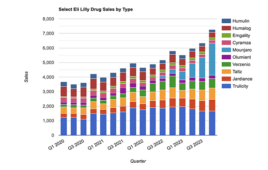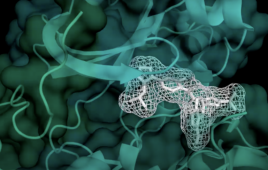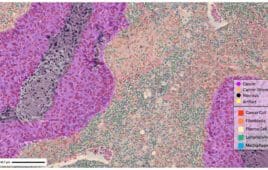In early 2022, secretive Altos Labs stunned with a record $3 billion launch to pursue anti-aging “cellular rejuvenation,” amid rumors of Jeff Bezos’ backing. But a roundup of the top 25 private healthcare and biotech companies reveals a landscape of grand ambitions to disrupt healthcare coupled with cautionary tales. Included in the mix is scandal-plagued…
Xaira’s $1 billion launch one of the biggest recent biotech funding rounds
The same week that BenevolentAI announced it was cutting 30% of its staff, AI-focused biotech Xaira Therapeutics debuted with a $1 billion funding round with little precedent in healthcare over the past year — or beyond that. A survey of the biggest fundraising rounds over the past year revealed that the absolute largest investments were…
From Novartis to Pfizer: A closer look at novel cell and gene therapy pricing and reimbursement strategies
Cell and gene therapies are upending the treatment of a growing number of diseases by addressing the underlying causes of genetic disorders. Yet the high costs associated with these therapies, sometimes costing multiple millions of dollars for a single treatment, pose significant challenges for patients, payers and healthcare systems. To address this matter, a growing…
With prices topping $4 million, high stakes define cell and gene therapy landscape
Cell and gene therapies often promise unparalleled treatment options for patients, but sometimes those benefits come at an extraordinary cost. The therapy class is responsible for the world’s most expensive drugs, including the recently FDA-approved gene therapy, Libmeldy, with a wholesale acquisition cost of $4.25 million. The prior record holder, Hemgenix, had a $3.5 million…
The $5-7B generative AI opportunity biopharma can’t afford to ignore
Yes, generative AI is hyped. And yes, the technology has shortcomings. But the landscape is swiftly changing. Bloomberg Intelligence estimated that the GenAI market would grow from $40 billion in 2022 to $1.3 trillion by 2032. A recent study from Deloitte Consulting estimates that for a top 10 biopharma company with $65-75 billion in revenue,…
Layoff tracker: Mapping the 11,000-plus biotech and pharma layoffs in early 2024
[Updated on April 25, 2024] While a number of biotech startups continue to attract healthy funding amounts, the biotech sector continues to see a significant number of layoffs in 2024 with major cuts hitting firms like Amylyx Pharmaceuticals, Novartis, Genentech and Sanofi. Bristol Myers Squibb (BMS) announced one of the largest workforce reductions of the…
Public vs. private: Who’s leading the charge in H5N1 preparedness?
The recent emergence of H5N1 avian influenza in humans and many other animals has intensified global efforts to prepare for a potential pandemic. Public health agencies and international organizations are collaborating with pharmaceutical companies and academic institutions to develop vaccines, treatments, and strategies to mitigate the impact of an outbreak. The CDC, for instance, has…
FDA approves pair of therapies for rare pediatric cancers: Novartis’ Lutathera and Day One’s Ojemda
The FDA has signed off on two novel therapies targeting rare pediatric cancers. Novartis’ Lutathera targets aggressive gastroenteropancreatic neuroendocrine tumors (GEP-NETs) in children 12 and up, while Day One Biopharma’s Ojemda (tovorafenib) tackles treatment-resistant BRAF-mutated relapsed or refractory pediatric low-grade glioma (pLGG) with a BRAF fusion or rearrangement, or BRAF V600 mutation These approvals offer…
Rilzabrutinib on track for regulatory filing after ITP trial win
Sanofi revealed that its investigational BTK inhibitor rilzabrutinib notched a significant win in the LUNA 3 phase 3 study, hitting the primary endpoint of durable platelet response in adults with persistent or chronic immune thrombocytopenia (ITP). The study showed a significantly higher proportion of rilzabrutinib-treated patients achieved the platelet response goal compared to placebo in…
New pharma and biotech manufacturing facilities and expansions announced worldwide for 2024
[Updated April 23, 2024] In the face of rising R&D costs and growing pricing pressures from payers, the pharma and biotech sectors continue to transform to adapt to an evolving landscape. While workforce reductions persist in 2024 for some companies, major players like AbbVie, AGC Biologics, Amgen, Novartis and Thermo Fisher Scientific are demonstrating confidence…
Study combines biomimetic AI, digital twins and multiomics to unveil potential genetic drivers of endometriosis
Endometriosis, a condition where endometrial tissue grows outside the uterus, has a strong genetic underpinning. A new study published in the Journal of Molecular Diagnostics sheds light on this connection. Researchers from a team including Genzeva, LumaGene, RYLTI Biopharma, Brigham & Women’s Hospital of Harvard University and QIAGEN Digital Insights used a unique approach in…
How the FDA approval of J&J’s Opsynvi could simplify treatment and improve outcomes for PAH patients
Pulmonary arterial hypertension (PAH), a rare, progressive and life-threatening blood vessel disorder, affects some 500 to 1,000 new patients each year in the U.S. FDA recently approved Opsynvi, a first-of-its-kind once-daily single-tablet combination therapy from Johnson & Johnson. “With this approval, our portfolio now includes treatments that address all three guideline-recommended pathways,” said a J&J…
The rise of ‘Ozempic babies’ and the uncharted territory of semaglutide in pregnancy
Ozempic, Rybelsus and Wegovy have transformed the diabetes and weight loss treatment landscape, but when it comes to the impact of their active ingredient, semaglutide, on fetal development, “the answer is we do not know,” said Dr. Marijane Hynes, clinical professor of medicine at the George Washington University School of Medicine and Health Sciences. Hynes…
As biotech struggles, Big Pharma spends and trims workers
Many smaller biotech companies continue to face a cash crunch as a result of a challenging funding climate and a difficult IPO market. In the past couple of years, many smaller biotechs are running out of cash and being forced to cut jobs or shut down entirely. Median deal sizes for seed, Series A and Series B rounds…
20 biotech startups attracted almost $3B in Q1 2024 funding
The top 20 healthcare-focused biotech companies collectively raised $2.9 billion in the first quarter of 2024, according to data sourced from Crunchbase. That represents a 161% increase compared to the $1.1 billion raised by the 20 largest funding rounds involving healthcare-focused biotech companies in Q1 2023, indicating more confident bets on the market viability of…
Global biotech VC trends in Q1 2024
The first quarter of 2024 saw a flurry of funding activity in the biotech sector, with early-to-mid-stage companies attracting most of the investment dollars. Among the most notable late-stage deals was blood-based cancer diagnostics firm Freenome‘s $254 million Series E round. The South San Francisco-based company, which is developing a platform for early cancer detection…
Machine learning model forecasts Lilly’s Mounjaro sales to triple in 2024
Novo Nordisk has received a considerable amount of attention for its meteoric growth of late, but Eli Lilly isn’t far off in that domain as of late. Lilly recently topped the S&P 500 healthcare index in terms of growth, jumping almost 34% as demand for its metabolic therapies surge. Last year, Lilly projected it would…
How digital pathology can help drug developers address the forked road in oncology and beyond
Digital pathology is disrupting the drug development process, replacing traditional microscopy rooted in Victorian Era approaches with high-resolution images and AI-powered analysis tools. In a recent editorial webinar, industry experts Nathan Buchbinder (chief strategy officer at Proscia), Dr. John Cochran (chief medical officer and chief pathologist at Q² Solutions, an IQVIA subsidiary), and Dr. Monika…
Pharmaceutical firms betting big on AI struggle to find the right people
Three-quarters of IT decision-makers at pharmaceutical companies plan to invest from $500,000 to $5 million in AI this year which, for many, doubles their budgets over the past year. That’s one of the findings based on the cross-industry research report involving 1,400 IT decision makers from Rackspace and AWS. “In terms of AI adoption, almost…
Why Atomwise sees a ‘generational shift’ in drug discovery with AI applied to screening
Atomwise’s AIMS (Artificial Intelligence Molecule Screening) project has demonstrated significant potential to accelerate drug discovery. In a landmark multiyear study published in Nature Scientific Reports, the project used Atomwise’s AI platform, AtomNet, to successfully identify structurally novel compounds across a diverse range of therapeutic targets. In the virtual high-throughput screening (HTS) study, AtomNet analyzed 318…
Forget efficiency, focus on shifting the standard of care with AI in drug discovery
Much has been made about AI’s potential to accelerate drug development timelines while chipping away at its often multi-billion-dollar price tag. But Abraham Heifets, CEO of Atomwise, believes that focusing on efficiency is not necessarily the right measure — or the right conversation — to have. Time for a different conversation “The two ways to…
Biotech market projection for 2024 could point to more sector stability
The biotech sector could see a period of relative stability, according to a time-series analysis of the NASDAQ Biotech Index. In recent years, however, performance of the NBI has had little bearing on the rate of layoffs in the pharma and biotech sectors. A statistical analysis of the relationship between the NBI performance and the…
Clinical trials have a diversity Problem. Real-world data could be part of the solution
While diversity in clinical trials has won attention in recent years, uneven representation of diverse populations in clinical trials remains a core barrier to global healthcare equity. Real-world data (RWD) paired with artificial intelligence techniques can almost instantly analyze how well drugs work in diverse subpopulations once they hit the market. RWD can also help…
Can payers afford the new era of GLP-1 drugs? Or can they afford not to?
The latest crop of glucagon-like peptide-1 (GLP-1) agonists, such as semaglutide and tirzepatide (technically, a dual GIP/GLP-1 receptor agonist), have upended the way we treat metabolic disorders, including obesity. These drugs mimic gut hormones, improving blood sugar control and often leading to significant weight loss. But as Kyasha Sri Ranjan, Ph.D., engagement manager at Lifescience…
Inside the AI-powered Roche-PathAI companion diagnostics collaboration
PathAI and Roche Tissue Diagnostics (RTD) have inked an exclusive collaboration to develop AI-enabled companion diagnostics that builds on their initial partnership announced in October 2021. To date, PathAI and Roche have commercially launched four algorithms through the partnership. The new partnership will provide biopharma sponsors with integrated technology for developing companion diagnostics incorporating AI-based…


















![[Adobe FIrefly]](https://www.drugdiscoverytrends.com/wp-content/uploads/2024/04/Firefly-Visualize-a-photo-realistic-HD-pharmaceutical-laboratory-image-with-concentrated-workers-in_-e1712103436381-268x170.png)





